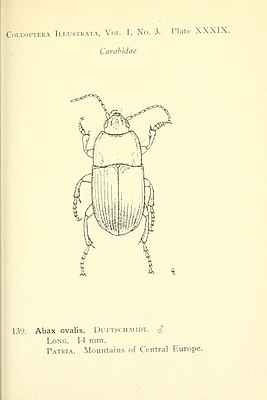Oval broad beetle
| Oval broad beetle | ||||||||||||
|---|---|---|---|---|---|---|---|---|---|---|---|---|

Oval broad beetle ( Abax ovalis ) |
||||||||||||
| Systematics | ||||||||||||
|
||||||||||||
| Scientific name | ||||||||||||
| Abax ovalis | ||||||||||||
| ( Duftschmid , 1812) |
The oval broad beetle ( Abax ovalis ) is a beetle from the family of ground beetles (Carabidae).
features
The oval broad beetle is an 11 to 15 millimeter large, pure black ground beetle, the upper side is somewhat shiny in both sexes. It is the smallest species of the genus Abax in Central Europe . The dorsoventral (from top to bottom) flattened body is short-oval in plan view. The pronotum is strong towards the front, hardly narrowed towards the base (that is the side facing the elytra), the base of the pronotum is roughly the width of the base of the wing cover. From the closely related and quite similar large beetle Abax parallelepipedus (synonym: Abax ater ) there is also the claw link of the legs, which has no bristles on the underside.
Occurrence and way of life
The animals are mainly found in Central Europe , but also in Italy or the Ukraine , especially in old beech forests. The species is common in Europe, from France in the west to Central Europe to Southeast Europe, it is absent in Western Asia. In Germany, with the exception of the north-east German flatlands, it is widespread in all parts of the country and is often not uncommon in forests, although it is more common in higher elevations than in the plains (collin to high montane). The occurrence in the Netherlands is limited to the Limburg hill country in the far south, the species is completely absent in the younger forests of the plain (mostly on sand).
The species is stenotopically specialized in forests and is considered a character species of the beech forests , but also occurs in oak-beech and oak-hornbeam forests . In coniferous and coniferous forests it is far less common or absent entirely. It is more common on limestone soils. The animal specializes in life in the interior of the forest and in an investigation kept a distance of 200 meters from the edge of the forest. In other investigations, however, it was also detected up to the edge of the forest.
The species is said to feed primarily on earthworms, but also on fresh carrion. As a big exception among the Central European ground beetles, it has a two-year development ( semivoltin ). The female digs a small hole in the ground or in the shelter of dead wood, in which she lays the eggs. She guards the clutch until the larvae hatch.
Endangerment and nature conservation
The oval broad beetle is not endangered in Germany. The animal is one of the German types of responsibility for which the Federal Republic of Germany has assumed a special obligation.
Phylogeny
With the closely related genera Molops , Tanythrix and Percus , the genus Abax , which includes around 17 species, belongs to a family group, the subtribe Molopina (earlier often understood as a tribe and called Molopini ). The togetherness and the monophyly of the genus were confirmed in molecular studies. However, the exact position of the species within the genus was not stable in the various investigations.
Web links
Information in the catalog of life.
Individual evidence
- ↑ a b 60. Genre: Abax BONELLI, 1810. In Heinz Freude, Karl-Wilhelm Harde, Gustav Adolf Lohse (founder), continued by Bernhard Klausnitzer: Die Käfer Mitteleuropas. Gerd Müller-Motzfeld (editor): Volume 2. Adephaga 1, Carabidae (ground beetles). 2nd (extended) edition 2004. Spectrum (Elsevier), Munich. ISBN 3-8274-1551-9
- ^ A b c Ekkehard Wachmann, Ralph Platen, Dieter Barndt: Laufkäfer. Observation, way of life. Naturbuch-Verlag, Augsburg 1995. ISBN 3-89440-125-7
- ↑ http://www.catalogueoflife.org/col/details/species/id/f5e08274b959590835a1173800a67edd/source/tree
- ↑ Hans Turin & Theodoor Heijerman (1988): Ecological classification of forest-dwelling Carabidae (Coleoptera) in the Netherlands. Tijdschrift voor Entomologie 131: 65-71.
- ↑ Stefan Müller-Kroehling (2013): Priorities for forest nature conservation - Bavaria's responsibility to protect biodiversity in forests, using the ground beetle (Coleoptera: Carabidae) as an example. Forest Ecology, Landscape Research, and Conservation 13: 57–72.
- ↑ Normann, Claudia, Christoph Scherber, Teja Tscharntke: How do tree species diversity and edge effects influence the species diversity of herbaceous plants and ground beetles in forests? , in: Feit, Ute and Horst Korn (ed.): Meeting point for biological diversity XIII. Interdisciplinary research exchange within the framework of the Convention on Biological Diversity, Federal Agency for Nature Conservation, Bonn 2014, pp. 75–80. ISBN 978-3-89624-105-4
- ↑ Tibor Magura, Béla Tóthméréz, Tivadar Molnár (2001): Forest edge and diversity: carabids along forest-grassland transects. Biodiversity and Conservation 10: 287-300.
- ^ Andrey V. Matalin (2008): Evolution of biennial life cycles in ground beetles (Coleoptera, Carabidae) of the Western Palaearctic. Proceedings of the XIII European Carabidologists Meeting, Blagoevgrad, August 20-24, 2007: 259-284.
- ↑ Pietro Brandmayr & Tullia Zetto-Brandmayr (1979): The evolution of parental care phenomena in Pterostichine ground beetles with special reference to the genera Abax and Molops (Coleoptera, Carabidae). Miscellaneous Papers Landbouwhogescool Wageningen 18: 35-49.
- ↑ https://biologischeevielfalt.bfn.de/bundesprogramm/foerderschwerpunkte/verendungungsarten.html
- ^ Andreas Düring & Martina Brückner (2000): The evolutionary history of the tribe Molopini: a first molecular approach. In Pietro Brandmayr (editor): Natural History and Applied Ecology of Carabid Beetles: Proceedings of the IXth European Carabidologists' Meeting (26-31 July 1998, Camigliatello, Cosenza, Italy): 1-4.
- ^ Achille Casale & Ignacio Ribera (2008): Are Molopina of the Euro-Mediterranean region related to the Madagascan, South African and Australian Pterostichini? (Coleoptera, Carabidae). Biogeographia 29: 35-44.
literature
- Wolfgang Lorenz (2017). CarabCat: Global database of ground beetles (version Oct 2017). In: Species 2000 & ITIS Catalog of Life, 20th December 2017. Digital resource at www.catalogueoflife.org/col. Species 2000: Naturalis, Leiden, the Netherlands. ISSN 2405-8858.